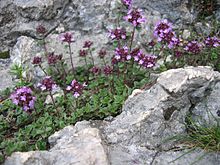早花百里香
外观
| 早花百里香 | |
|---|---|

| |
| 早花百里香 Thymus praecox var. praecox | |
| 科学分类 | |
| 界: | 植物界 Plantae |
| 演化支: | 维管植物 Tracheophyta |
| 演化支: | 被子植物 Angiosperms |
| 演化支: | 真双子叶植物 Eudicots |
| 演化支: | 菊类植物 Asterids |
| 目: | 唇形目 Lamiales |
| 科: | 唇形科 Lamiaceae |
| 属: | 百里香属 Thymus |
| 种: | 早花百里香 T. praecox
|
| 二名法 | |
| Thymus praecox | |
| 亚种 | |
|
见正文。 | |
早花百里香(学名:Thymus praecox)是唇形科百里香属的一个种,分布于西亚北部、欧洲和格陵兰。[1]可栽培作观赏或作为香料。
早花百里香与铺地百里香十分相似,因此容易混淆。
形态
[编辑]匍伏性小灌木,可长至25公分宽。木质走茎末端可能开花或不开花。开花茎直立,不长于10公分,基部簇生叶片。茎四方型,两侧或四侧被毛。叶对生,倒卵形、宽匙形至接近圆形,基部革质有毛,支脉明显,上侧有缘脉。苞片类似叶片。两性花,左右对称花,花萼5片3~5mm长,花瓣5片紫色至粉红色。果实为坚果,细小。
染色体数 2n = 56,少见 54。
亚种
[编辑]

茎四面均匀被毛的亚种[1]:
- 早花百里香 Thymus praecox subsp. praecox[2]
- 无柄早花百里香 Thymus praecox subsp. jankae (Celak.) Jalas[2]
- 微小百里香 Thymus praecox subsp. parvulus (Lojac.) Bartolucci, Peruzzi & N.G.Passal.[3]
- 毛高加索百里香 Thymus praecox subsp. grossheimii (Ronniger) Jalas[4]
茎相对两面被毛、另两面无毛或稀毛的亚种:
- 半毛百里香 Thymus praecox subsp. polytrichus (A.Kern. ex Borbás) Jalas[2]
- 不列颠百里香 Thymus praecox subsp. britannicus (Ronniger) Holub[5]
- 高加索百里香 Thymus praecox subsp. caucasicus (Willd. ex Ronniger) Jalas[4]
- 奥地利百里香 Thymus praecox subsp. widderi (Ronniger ex Machule) P.A.Schmidt[2]
- 阿尔巴尼亚百里香 Thymus praecox subsp. zygiformis (Heinr.Braun ex Wettst.) Jalas[2]
人类利用
[编辑]
可作为观赏植物,适合作为庭园或盆栽的铺地植物。
也可以作为香料加入食物中或泡茶,其气味在不同植株间有很大的差异。[6][7][8]
参考资料
[编辑]- ^ 1.0 1.1 Thymus praecox Opiz. Catalogue of Life. [2020-01-18].
- ^ 2.0 2.1 2.2 2.3 2.4 Tutin, T. G.; Heywood, V. H.; Burges, N. A.; Moore, D. M.; Valentine, D. H.; Walters, S.M.; Webb, D. A. Flora Europaea 3. Cambridge, UK: Cambridge University Press. 1972. ISBN 9780521084895.
- ^ Bartolucci, F.; Domina, G. The genus Thymus (Lamiaceae) in Sicily. Plant Biosystems - An International Journal Dealing with all Aspects of Plant Biology. 2015-07-04, 149 (4): 710–719. ISSN 1126-3504. doi:10.1080/11263504.2015.1057259.
- ^ 4.0 4.1 Greuter, Werner; Raus, Thomas. Med-Checklist Notulae, 12. Willdenowia. 1986, 15 (2): 413–432. ISSN 0511-9618.
- ^ Holub, J. Brief notes on the third volume of "Flora Europaea". Preslia. 1973, 45: 355-360 [2021-02-27]. (原始内容存档于2020-11-30).
- ^ Stahl-Biskup, E, The Essential Oil from Norwegian Thymus Species. I. Thymus praecox ssp. Arcticus, Planta Medica, Feb 1986, 52 (1): 36–8, ISSN 0032-0943, doi:10.1055/s-2007-969062
- ^ Stahl, Elisabeth, Chemical polymorphism of essential oil in Thymus praecox ssp. Arcticus (Lamiaceae) from Greenland, Nordic Journal of Botany, 1984, 4 (5): 597–600, doi:10.1111/j.1756-1051.1984.tb01985.x
- ^ Schmidt, A, Essential oil polymorphism of Thymus praecox subsp. Arcticus on the British Isles, Biochemical Systematics and Ecology, 2004, 32 (4): 409–421, doi:10.1016/j.bse.2003.10.003
